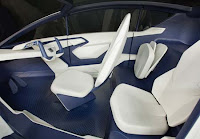Honda Accord EX-L Sedan, 2008




The all-new 2008 Honda Accord moves the world of mainstream transportation in a refined, dynamic and sophisticated direction with an expanded range of innovative technologies designed for more power, greater efficiency and enhanced safety across the entire lineup of sedans and coupes.
Completely redesigned for 2008 with increased dimensions for a more spacious interior, the sedan styling theme expresses a powerful presence with sharp and strong character lines. The coupe is further individualized with an aggressive stance and unique proportions that create a muscular, sporty demeanor.
"The all-new Honda Accord has become more advanced and refined with a new level of engineering sophistication," said John Mendel, executive vice president of American Honda Motor Co., Inc. "As the Honda brand's flagship automobile, the Accord is designed to exceed expectations with premium technology, a more spacious interior and increased power, while retaining the fun-to-drive character and innovative feel that has always distinguished the Accord."
The Accord is available in sedan and coupe body styles with 2.4-liter 4-cylinder and 3.5-liter V-6 engine choices. Available transmissions include a 5-speed manual (standard with all 4-cylinder engines), a 5-speed automatic (standard on sedan V-6 models, available with all 4-cylinder engines and V-6-powered Accord Coupes,) and a 6-speed manual transmission (exclusive to the Accord Coupe EX-L V-6 6MT).
Sedan trim levels range from the well-equipped Accord Sedan LX and plus-featured LX-P (177-horsepower 4-cylinder engine), to the nicely-equipped Accord Sedan EX (190-horsepower 4-cylinder engine or 268-horsepower V-6 engine), to the premium and upscale Accord Sedan EX-L (190-horsepower 4-cylinder engine or 268-horsepower V-6 engine). Coupe trim levels range from the well-equipped Accord Coupe LX-S (190 horsepower 4-cylinder engine), to the nicely-equipped Accord Coupe EX (190-horsepower 4-cylinder engine) to the premium and upscale Accord Coupe EX-L (190-horsepower 4-cylinder engine or 268-horsepower V-6 engine).
Interior
Premium quality with a simple, modern and spacious design describes the philosophy behind the Accord's interior. The larger Accord Sedan total interior volume of 120.0 cubic feet (+3.3 cubic feet compared to 2007) moves the EPA classification from the midsize sedan class to the large sedan class. The additional space is intended to provide "equal" seating comfort for front and rear passengers. Rear legroom of 37.2 inches (+0.4 inches) approaches the impressive second row legroom of the Honda Pilot SUV (37.4 inches). The wider interior (+1.5 inches) allows the front seats to be positioned farther apart to allow for a wide center console more commonly associated with the finest luxury vehicles.
The Accord interior is designed for a dynamic, intuitive and upscale presence, starting with an easy-to-read information display on every vehicle. A zone styling approach separates operation-related instruments (top) and information-related instruments (lower). At night, the controls are further separated by color to distinguish between climate controls (aqua green) and audio controls (white). Classically-styled gauges for the speedometer and tachometer are perfectly round (instead of being truncated at the bottom). Steering wheel audio controls are standard on every Accord. Careful attention was paid to the symmetry of the exterior and interior of the vehicle - including sight lines related to the dashboard height and the visual presence of the hood to the driver.
Redesigned front bucket seats are larger, and feature substantial lateral support to complement the Accord's sporting side. The fold-down lockable rear seatback increases cargo-carrying versatility; the sedan includes a lockable pass-through.
Exterior
Intended to convey a prestigious presence, the Accord Sedan embraces a traditional three-box shape that emphasizes both a dynamic and athletic feel with the sophistication of a timeless sedan form. Dimensionally, the Accord Sedan's overall length of 194.1 inches (4-cylinder models, V-6 models add 0.2 inches for front spoiler lip) is 3.0 inches longer than the 2007 model. The width of 72.7 inches is 1.1 inches wider, and the height of 58.1 inches is 0.9 inches taller. Even though the size is larger in every dimension, the vehicle's torsional rigidity has increased by 20 percent as a result of advanced body construction that uses 48 percent high-tensile steel - the most high-tensile steel by volume of any Accord to date. A significant benefit to the advanced body construction is that total vehicle weight increased only by approximately 5 percent despite the larger size, greater rigidity and added features.
The Accord Coupe styling radically breaks from the sedan with a uniquely aggressive image. Its long hood, sleek roofline and muscular lines suggest power and a heightened agility compared to the sedan. Dimensionally, the Accord Coupe's overall length of 190.9 inches is 3.2 inches longer than 2007 model, its width of 72.8 inches is 1.2 inches wider, and its height of 56.4 inches is 0.6 (LX-S) to 0.7 (EX, EX-L) inches higher. Compared to the 2008 Accord Sedan, the Accord Coupe is 3.2 inches shorter in length, 1.7 inches shorter in height and 0.1-inch wider.
























